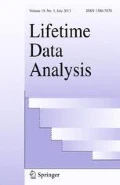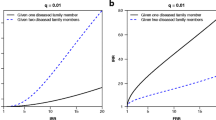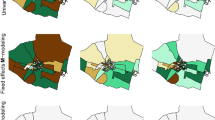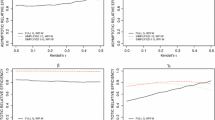Abstract
Family-based follow-up study designs are important in epidemiology as they enable investigations of disease aggregation within families. Such studies are subject to methodological complications since data may include multiple endpoints as well as intra-family correlation. The methods herein are developed for the analysis of age of onset with multiple disease types for family-based follow-up studies. The proposed model expresses the marginalized frailty model in terms of the subdistribution hazards (SDH). As with Pipper and Martinussen’s (Scand J Stat 30:509–521, 2003) model, the proposed multivariate SDH model yields marginal interpretations of the regression coefficients while allowing the correlation structure to be specified by a frailty term. Further, the proposed model allows for a direct investigation of the covariate effects on the cumulative incidence function since the SDH is modeled rather than the cause specific hazard. A simulation study suggests that the proposed model generally offers improved performance in terms of bias and efficiency when a sufficient number of events is observed. The proposed model also offers type I error rates close to nominal. The method is applied to a family-based study of breast cancer when death in absence of breast cancer is considered a competing risk.
Similar content being viewed by others
References
Bender R, Augustin T, Blettner M (2005) Generating survival times to simulate Cox proportional hazards models. Stat Med 24: 1715–1723
Chen B, Kramer J, Greene M, Rosenberg P (2008) Competing risks analysis of correlated failure time data. Biometrics 64: 172–179
Cheng Y, Fine J (2008) Nonparametric estimation of cause-specific cross hazard ratio with bivariate competing risks data. Biometrika 95: 233–240
Cheng Y, Fine J, Kosorok M (2007) Nonparametric association analysis of bivariate competing-risks data. J Am Stat Assoc 102: 1407–1415
Clayton D (1978) A model for association in bivariate life tables and its application in epidemiological studies of familial tendency in chronic disease incidence. Biometrika 65: 141–151
Clayton D, Cuzick (1985) Multivariate generalizations of the proportional hazards model. J R Stat Soc Ser A 148: 82–117
Fine J, Gray R (1999) A proportional hazards model for the subdistribution of a competing risk. J Am Stat Assoc 94: 486–509
Glidden D (2000) A two-stage estimator of the dependence parameter for the Clayton-Oakes model. Lifetime Data Anal 6: 141–156
Glidden D, Self S (1999) Semiparametric likelihood estimation in the Clayton-Oakes failure time model. Scand J Stat 26: 363–372
Glidden D, Vittinghoff E (2004) Modeling clustered survival data from multicenter clinical trials. Stat Med 23: 369–388
Gray R (1988) A class of k-sample tests for comparing the cumulative incidence of a competing risk. Ann Stat 16: 1141–1154
Hougaard P (2000) Analysis of multivariate survival data. Springer-Verlag, New York
Hsu L, Gorfine M, Malone K (2007) On robustness of marginal regression coefficient estimates and hazard functions in multivariate survival analysis of family data when the frailty distribution is mis-specified. Stat Med 26: 4657–4678
Kalbfleisch J, Prentice R (2002) The statistical analysis of failure time data. 2. Wiley, New York
Katsahian S, Resche-Rigon M, Chevret S, Porcher R (2006) Analysing multicentre competing risks data with a mixed proportional hazards model for the subdistribution. Stat Med 25: 4267–4278
Klein J (1992) Semiparametric estimation of random effects using the Cox model based on the EM algorithm. Biometrics 48: 795–806
Kramer J, Velazquez I, Chen B, Rosenberg P, Struewing J, Green M (2005) Prophylactic oophorectomy reduces breast cancer penetrance during prospective long-term follow-up of BRCA1 mutation carriers. J Clin Oncol 23: 8629–8635
Leemis L (1987) Variate generation for accelerated life and proportional hazards models. Oper Res 35: 892–894
Leemis L, Shih LH, Reynertson K (1990) Variate generation for accelerated life and proportional hazards models with time dependent covariates. Stat Probab Lett 10: 335–339
Lin D (2007) On the Breslow estimator. Lifetime Data Anal 13: 471–480
Nielsen G, Gill R, Andersen P, Sørensen T (1992) A counting process approach to maximum likelihood estimation in frailty models. Scand J Stat 18: 25–43
Oakes D (1989) Bivariate survival models induced by frailties. J Am Stat Assoc 84: 487–493
Pepe M, Mori M (1993) Kaplan–Meier, marginal or conditional probability curves in summarizing competing risks failure time data. Stat Med 12: 737–751
Pintilie M (2006) Competing risks: a practical perspective. Wiley, England
Pipper C, Martinussen T (2003) A likelihood based estimating equation for the Clayton-Oakes model with marginal proportional hazards. Scand J Stat 30: 509–521
R Development Core Team: (2009) R: a language and environment for statistical computing. R foundation for statistical computing. Vienna, Austria
Rutter J, Smith A, Dávilla M, Sigurdson A, Giusti R, Pinede M, Doody M, Tucker M, Greene M, Zhang J, Struewing J (2005) Mutational analysis of the BRCA1-interacting genes ZNF350/ZBRK1 and BRIP1/BACH1 among BRCA1 and BRCA2-negative probands from breast-ovarian cancer families and among early-onset breast cancer cases and reference individuals. Hum Mutat 22: 121–128
Shih J, Louis T (1995) Assessing gamma frailty models for clustered failure time data. Lifetime Data Anal 1: 205–220
Struewing J, Brody L, Erdos M, Kase R, Giambarresi T, Smith S, Collins F, Tucker M (1995) Detection of eight BRCA1 mutations in 10 breast/ovarian cancer families, including 1 family with male breast cancer. Am J Hum Genet 57: 1–7
Author information
Authors and Affiliations
Corresponding author
Rights and permissions
About this article
Cite this article
Dixon, S.N., Darlington, G.A. & Desmond, A.F. A competing risks model for correlated data based on the subdistribution hazard. Lifetime Data Anal 17, 473–495 (2011). https://doi.org/10.1007/s10985-011-9198-9
Received:
Accepted:
Published:
Issue Date:
DOI: https://doi.org/10.1007/s10985-011-9198-9




